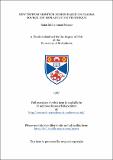Files in this item
A new tritium monitor design based on plasma source ion implantation technique
Item metadata
| dc.contributor.advisor | Watt, D. E. | |
| dc.contributor.author | Nassar, Rafat Mohammad | |
| dc.coverage.spatial | 168 p. | en_US |
| dc.date.accessioned | 2018-05-17T10:48:39Z | |
| dc.date.available | 2018-05-17T10:48:39Z | |
| dc.date.issued | 1997-06 | |
| dc.identifier.uri | https://hdl.handle.net/10023/13373 | |
| dc.description.abstract | Tritium is an important isotope of hydrogen. The availability of tritium in our environment is manifest through both natural and artificial sources. Consequently, the requirement for tritium handling and usage will continue to increase in the future. An important future contributor is nuclear fusion power plants and facilities. Essential safety regulations and procedures require effective monitoring and measurements of tritium concentrations in workplaces. The unique characteristics of tritium impose an important role on the criteria for its detection and measurement. As tritium decays by the emission of soft beta particles, maximum 18 keV, it cannot be readily detected by commonly used detectors. Specially built monitors are required. Additional complications occur due to the presence of other radioactive isotopes or ambient radiation fields and because of the high diffusivity of tritium. When it is in oxidized form it is 25000 times more hazardous biologically than when in elemental form. Therefore, contamination of the monitor is expected and compound specific monitors are important. A summary is given of the various well known methods of detecting tritium-in-air. This covers the direct as well as the indirect measuring techniques, although each has been continually improved and further developed, nevertheless, each has its own limitations. Ionization chambers cannot discriminate against airborne P emitters. Proportional counters have a narrow operating range, 3-4 decades, and have poor performance in relatively high humid environments and require a dry counting gas. Liquid scintillation counters are sensitive, but inspection of the sample is slow and they produce chemical liquid waste. A new way to improve the sensitivity of detecting tritium with plastic scintillators has been developed. The technique is based on a non-line-of-sight implantation of tritium ions into a 20 mum plastic scintillator using a plasma source ion implantation (PSII) technique, This type of source is different, superior to the line-of-sight implantation and requires no additional beam handling. It is capable of implanting ion species in a broad beam configuration into the entire surface of a target. The technique requires a special ion source with special characteristics of the type obtained from a surfatron plasma source. This ion source has a large high ion density plasma with minimum contamination and produces ions of low temperature. It was constructed to ionize the sampled air and to produce a plasma over a wide range of pressure, 4-0.1 mTorr. A plasma source ion implantation cell was designed and constructed using mathematical modeling with personal computer, to optimize the essential variables of the design and to estimate the implantation rate under different operation conditions. Also, a high voltage pulse modulator was designed and constructed to produce a series of 10 musec pulses (up to 2 MHz) with a maximum magnitude of -60 kV. The developed device was capable of ionizing air samples and implanting the resulting ions into a plastic scintillator. Two different methods to enhance the collection and deposition of the tritium ions, have been proposed and assessed. A movable prototype device for monitoring environmental tritium in air has been designed and constructed. Although this prototype was not fully tested, the primary calculations have shown that measurable concentrations of tritium ions can be collected from an air sample, with tritium activity ranging from 0.3 Bq/cm3 down to 0.03 mBq/cm3, in a short time, to the order of seconds, on-line. This sensitivity fulfills the requirement for environmental monitoring. | en_US |
| dc.language.iso | en | en_US |
| dc.publisher | University of St Andrews | |
| dc.subject.lcc | RA1231.T8N2 | |
| dc.subject.lcsh | Tritium--Toxicology | |
| dc.title | A new tritium monitor design based on plasma source ion implantation technique | en_US |
| dc.type | Thesis | en_US |
| dc.type.qualificationlevel | Doctoral | en_US |
| dc.type.qualificationname | PhD Doctor of Philosophy | en_US |
| dc.publisher.institution | The University of St Andrews | en_US |
This item appears in the following Collection(s)
Items in the St Andrews Research Repository are protected by copyright, with all rights reserved, unless otherwise indicated.

